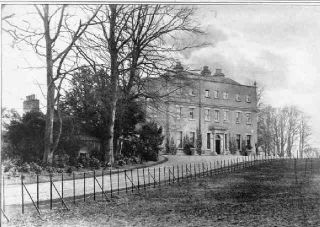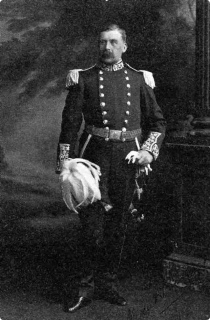Everard of Randalstown
Everard Family
Randalstown House
(See also Tobacco)

Randalstown House (pictured left) was located to the north of Navan. The house was begun about 1710 and extended twice in the eighteenth century. It stood to the late twentieth century. A three storey over basement house, Randalstown had a pillared Doric doorcase. Bence Jones wrote that Randalstown had the most imaginative late Georgian interior plasterwork with trophies and roped swags on the domed staircase.
The Everards of Randalstown can be traced back to the 15th century. Owen Randill of Rendillstown had a daughter Olive, who married Pierce Cardy and inherited Rendillstown. Their daughter, Joan Cardy, married John Everard in the early 1400s and so the Everards came to live at Randalstown.
In 1519 Patrick Everard of Randalstown was Sheriff of Meath. Matthias Everard joined the forces of James II in fighting William of Orange. He served during the siege of Limerick in 1691 and under the Treaty of Limerick he submitted to the King and paid £1000 to be restored to this lands. Matthias renovated the old castle at Randalstown and extended in 1708 and 1714, thus creating a country house. Matthias died in 1715 and was buried at Kilberry.
His younger brother, Christopher, inherited the estate. He completed the new road from Navan to Donaghpatrick which had been started by his brother. In 1720 Christopher erected a banqueting house flanked by a canal and a terrace. In 1744 Ranadalstown was described as being well wooded and with a great avenue of full grown ash trees. In 1748 John Everard of Randalstown conformed to the Established Protestant church. About 1780 Thomas Everard added a third storey of Randalstown. The interior was remodelled with the main front on the south side being turned round to the north side where a pillared doorcase was erected. In 1795 Thomas was High Sheriff of Meath and was a member of the Grand Jury from 1785 until his death in 1820.
He was succeeded by his son, Matthias. Matthias Everard of Randalstown, born about 1787, commenced his military career at Gibraltar in 1804. In December 1805 Lieutenant Everard was captured on his way from Gibraltar to England by the French fleet. The English prisoners were held on board the La Volontaire which three months later sailed into the British controlled Cape and the prisoners were released. A few years later he participated in the attempt to capture the Spanish colony of Rio de la Plata. He led an attack on Montivideo. Out of the 32 men, 22 were killed or wounded. He was presented with a sword of honour to mark his gallantry by the Patriotic Fund at Lloyds and granted the freedom of Dublin. Promoted to Captain in 1807 Mathias served at Corunna in 1809. After the Napoleonic war Everard was transferred to India and commanded the 1st Batallion at the siege of Hattras in 1817. In 1821 he was appointed major and in 1825 lieutenant colonel. Everard commanded the 14th Regiment at the storming of Bhurtpore in India in 1825. In 1826 he was awarded the companion of the Order of the Bath. In 1841 he was appointed Colonel and in 1851 Major-General. Matthias inherited Randalstown in 1845 but never lived there. He died in 1857 at Southsea, Southampton, unmarried.
In 1837 Randalstown was the property of Col. Everard but the residence of Henry Meredith. It was described as a fine three storey house with a basement situated in an elegant and extensive estate. In 1855 the property as still occupied by Henry Meredith. Matthias was succeeded by his brother, Richard Nugent Everard, who died in 1863.
Sir Nugent Talbot Everard (pictured below) was born at Torquay, Devon in England in 1849 and he was the first of the Everards

to make their home at Randalstown for more than 60 years. In 1863 at the age of thirteen he inherited Randalstown. He was educated at Harrow and Trinity College, Cambridge. He settled at Randalstown about 1870. At the time the estate amounted to 2311 acres. Everard was a supporter of the Irish Agricultural Organisation Society which established the co-operative movement in Ireland. Everard was elected President of the co-op movement, the I.A.O. S., in 1905.
On the occasion of the coronation of King George V in 1911 Everard was created a baronet. He was a member of the Grand Jury of Meath and its successor Meath County Council. He held the position of High Sheriff and Lord Lieutenant for Meath, and was a co-opted member of the county council, serving continuously from 1899 to 1922. He served with his wife, Lady Everard, on the Meath Agricultural Society and the County Committee of Agriculture. He served in the Royal Meath Milita and served as colonel of the Leinster Regiment in Belgium and at Ypres.
Sir Nugent Everard and his son, Richard, were staying in the Sackville Street Club when the rebellion broke out and remained there while the fighting continued. They witnessed the fighting at the GPO and the surrender of the leaders. Sir Nugent kept a diary now in the possession of the family of the five days of the rebellion. In 1922 he was appointed to the Senate of the new Irish Free State by William T. Cosgrave.
The demise of tillage farming in the 1880s and the consequent decrease in employment opportunities on the land for his workers made him turn his attention to tobacco. (Click for more on tobacco.) In 1898 Sir Nugent Talbot Everard obtained a special licence to grow tobacco. He was joined in the next few years in the experiment by Sir John Dillon of Lismullin, R.H. Metge of Athlumney and F. Brodigan of Piltown. His tobacco growing is mentioned in James Joyce's Ulysses; – “there was that Colonel Everard down there in Navan growing tobacco”. From 1898 to 1938 the Randlestown area of Navan was central to plans to introduce tobacco growing on a commercial basis in Ireland. The estate had its own tobacco plantation and also acted as a rehandling station – taking in tobacco from the local growers and processing it for sale to factories. At its peak, the industry provided almost 100 jobs and played a vital part in the local economy. Col. Everard died in 1929 in his eightieth year. He is interred at Donaghpatrick – his grave is near the entrance.
There is an article about Sir Nugent Everard in the 2000 issue of Riocht an Midhe. After his death the local growers formed the County Meath Co-Operative Tobacco Growers' Society. The Co-Operative continued into the 1930s, and closed in 1939, the last year in which tobacco was grown in the county. Sir Nugent's only son, Major Richard Everard succeeded him at Randalstown but eleven days later died suddenly. His eldest son became Sir Nugent Everard. He decided to join the British army in 1926 and saw active service during World War II. Richard Everard provides much information of the Everard family in the 1993 and 1994 issues of the Irish Genealogist journal. By 1940 Randalstown house was empty and in 1943 it was sold with 412 acres of land to Gerald Williamson. The Williamson family held the property for thirty years until it was purchased by Tara Mines. The house was used for a period as offices for the mines but finally the house was demolished in the 1970s to make way for the Tarta Mines tailings dam.
Source: meath-roots.com
See also the journal of the Navan & District Historical Society Navan - its People and its Past vol. 2 (2013) pp. 106-110 for information of Sir Nugent Everard and WW1.